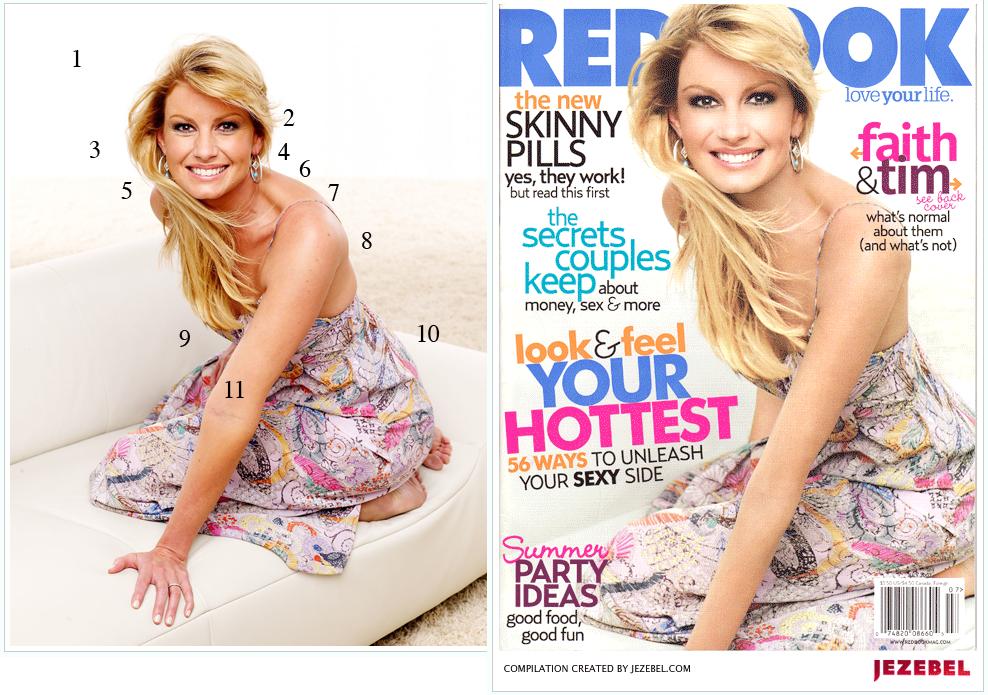The Mechanics of Beauty
When was the last time a woman’s fashion magazine was printed without a stunning celebrity on the cover, or without a face on it at all? These magazines, such as Vogue, Cosmopolitan, and Seventeen, display decorated covers of decorated women; models, musicians and artists grace our grocery checkout lines with their feminine presence. With the rise of digital technology, however, magazine editors have the ability to alter their cover model’s image to perfection—the end product is a blemish and wrinkle free face, with impeccable hair and a body to match. Is this purely a marketing technique? The phenomena of “celebrity status” creates an “us-them” dynamic, which is infinitely exacerbated by the uncanny flawlessness that magazine covers imply. Thus, the photographic depiction of these familiar and beautiful women is not only a marketing technique, but is also a manipulation of the power dynamic implied between the average woman and her above average celebrity counterpart. Additionally, magazine images of celebrity women are directly and indirectly affecting the female consumer; digital productions of women are creating an unobtainable ideal of all that is feminine. Why are we striving to achieve the look of someone—something—that is no longer human?
While Photoshop mistakes are no doubt entertaining, the consumer rarely gets to see the full extent to which magazine images are digitally retouched. Online pop-culture blog Jezebel.com held a contest asking for its readers to provide a “before” picture of a retouched magazine cover, and the July 2007 cover of Redbook was the winning entry (Jezebel.com, 2007). The beautiful country singer Faith Hill, pictured on this cover, was digitally nipped and tucked to perfection—but what was so wrong with her before? Jezebel revealed just what had been altered through a controversial on-line post. In a series of 11 steps, Faith Hill went from a natural beauty to a production of technology, all the while maintaining an heir of humanness. Her wrinkles, posture, clothing, arms, hair, skin tone and ears are only some of what were altered. Overall, the end photo of Hill portrayed a woman more or less unaffected by the process of ageing, and 15-20 pounds lighter than she started. Redbook editor Stacy Morrison rebutted, “In the end, they’re not really photographs. They’re images” (2007). UK GQ editor Dylan Jones added, “These days you only get two kinds of pictures of celebrities—paparazzi pictures or pictures like these which have been highly styles, buffed, trimmed and altered to make the subject look as good as is humanly possible” (BBC News, 2003). Ironically enough, these “images” are the exact opposite: not humanly possible at all.
It is assumed that these pictures set a standard of beauty, and that women of all ages turn to the fashion magazines as a how-to guide; how to do beauty, how to do success, and how to do femininity. Is this actually the case? In a study on the subject, Melissa Milkie outlines the “third party” effect (Milkie, 1999) . Most participants were able to assert that commercial images of women are “unrealistic and unobtainable,” but the issue lies in individuals believing that commercial images set the standards of beauty for other people much more so than for themselves (1999). A more direct example of internalizing female beauty standards is illustrated in the 1995 introduction of Western television to the country of Fiji. While Fiji was once considered a nation where nobody was dieting (BBC News, 1999), researchers found that only three years after the introduction of western television, “74% of [women] felt they were ‘too big or fat’.” Additionally, there was a significant emergence of what Western nations call “eating disorders”, rarely previously recorded in the Fiji population (1999).
Is society a reflection of the media, or is the media a reflection of society? I would argue that society existed long before the media, but because of its normalization and prevalence, society tends to forget that we, as a culture, have created the media and imbedded ourselves within it. The gender roles of our society are absorbed by the media and thus reflected back into society; there is an interactive relationship. For women specifically, reminders of societal expectations are pervasive and effective. Women buy the magazines, buy the products, and attempt to change their appearance in accordance with what they believe is expected of them. The irony here, however, is that with the help of technology, women will never succeed in obtaining that which they judge to be perfection. Flawless, digital productions are forever increasing the market value of magazines and their corresponding products, while simultaneously decreasing the market value of the natural female body.
The rise of technologies such as Photoshop allow for magazine editors to digitally remaster the depiction of the women on their covers. These images do not represent an obtainable ideal; they are cyborgs, a technological compilation of natural beauty and machinery, infinitely inaccessible. Nevertheless, female cover models are easily portrayed by a female audience as “supreme”: they are the next best thing, and a better you. In order to control the strong hold the media has on female gender ideals and stereotypes, we, as a society must first realize that we have the power to change the media, and consequently find a way for the average woman to detach herself from the superhuman depictions found on magazine covers. Once she is able to do so, the technology of mass media will have no choice but to transform as well. But the question remains: how?
References
Milkie, M. A. (1999, June). Social comparisons: reflected appraisals, and mass media: the impact of pervasive beauty images on black and white girls’ self-concepts. American Sociological Association, 62(2).
Here’s our winner! ‘Redbook’ shatters our ‘faith’ in well, not publishing, but maybe God [Online blog]. (2007, July 16). Retrieved March 6, 2009, from Jezebel.com Web site: http://jezebel.com/gossip/photoshop-of-horrors/.
Magazine admits airbrushing Winslet. (2003, January 20). Retrieved March 6, 2009, from BBC News Web site: http://news.bbc.co.uk/2/hi/entertainment/2643777.stm .
TV brings eating disorders to Fiji. (1999, May 20). Retrieved March 6, 2009, from BBC News Web site: http://news.bbc.co.uk/2/hi/health/347637.stm.
Comments are closed.


Maddie—
I said, in response to your last paper, that the phenomenon of transgender is significant precisely because it highlights the creakiness of the system that binds us all. I think this paper—in highlighting the effect that digital images have on consumers—makes much the same point, highlighting the ways in which we are all bound to impossible standards of beauty.
You acknowledge that, having created media, we are (re-) created by it, holding ourselves to the images it produces. This is the by-now classic argument about advertising—that it produces images that are intended to make us feel dissatisfied with ourselves, so that we will go buy the products being offered (see John Berger’s Ways of Seeing for the best explication of this phenomenon).
You also argue that, given the bi-directionality of this relationship, we have the power to change it–to “detach ourselves from the superhuman depictions.” You end w/ the question “how,” but I’d very much like to throw that query back @ you. Can you think of some concrete interventions? Do you know of any that are already operative? Without some suggestions, your paper reinforces a loop that seems hopeless…
Along these lines, you might want to look @ the essays that Natasha and Rebecca wrote on related dynamics. Both of them end w/ hopeful gestures toward the possibilities of change that such a “loopy” process ensures…